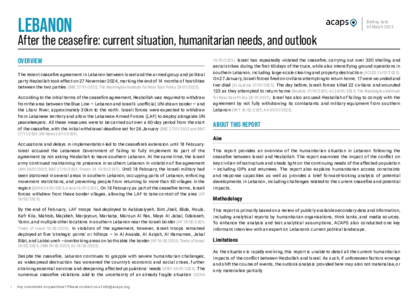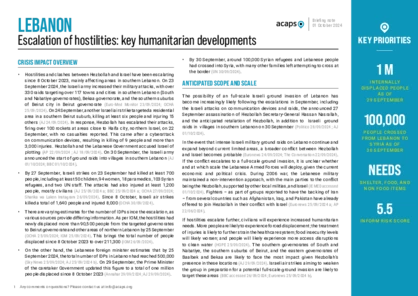Latest updates on country situation
30 July 2025
The escalation of hostilities between Hezbollah and Israel displaced over 500,000 children, mainly from southern Lebanon, between September–November 2024, before a ceasefire was reached. While most IDPs have since returned, around 31% of the displaced children (approximately 155,000) remained out of school as of July 2025. Over 770 educational facilities were repurposed as shelters, and nearly 400 schools were completely closed because of sustained bombardment. Although fighting ceased in November, many schools remained inaccessible or damaged; 19 were still being used as shelters in December. Around 66% of families with out-of-school children also cite financial barriers, such as high school fees, transport costs, and lack of materials. The prolonged disruption to education has increased children’s risk of exploitation, including child labour and harassment, especially for those residing in overcrowded shelters or homes lacking privacy. Girls are disproportionately affected, as economic hardship and social norms often lead to early marriage or withdrawal from school for domestic responsibilities. (ESCWA 24/07/2025, Health Cluster 22/07/2025, UNICEF 28/02/2025)
26 March 2025
By 20 March 2025, more than 21,600 Syrians had arrived in Lebanon following the hostilities that occurred between 7–10 March in Hama, Homs, Lattakia, and Tartous governorates. Most of the new arrivals are hosted in Akkar governorate, northern Lebanon, with relatives and friends or in collective shelters. NFIs, ready-to-eat meals, and shelter are among the urgent needs reported. (UNHCR 23/03/2025, Ahram 25/03/2025)
12 March 2025
Between 7–10 March 2025, clashes erupted between forces of the Syrian caretaker government and supporters of the previous regime of Bashar Al Assad in Northwest Syria. The violence killed an estimated 1,000 people in the affected areas of Latakkie and Tartous governorates and displaced at least 45,000, who need shelter, food, medical aid, and protection. Insecurity restricts humanitarian access to the conflict area as aid workers fear abduction and physical threats. The fighting damaged six hospitals, several ambulances, and power lines. Many people have crossed to Akkar and Tripoli governorates in Lebanon, including at least 10,000 to Akkar. They take informal routes, as Israeli air strikes damaged the official border crossing during the escalation with Hezbollah in 2024. Issues include a lack of formal registration among new arrivals, a lack of organised aid, and heavy reliance on individual initiatives to provide aid for the new arrivals. (UN 10/03/2025, Sari Global 10/03/2025, TNA 09/03/3035)
23 January 2025
Between December 2024 and March 2025, 30% of the analysed population is projected to experience Crisis (IPC Phase 3 and above) levels of food insecurity or worse, an increase from the 19% recorded during the same period in 2024. This rise is attributed to the escalation of hostilities between Hezbollah and Israel since 8 October 2023, coupled with economic deterioration and rising inflation. (IPC 17/01/2025, IPC 07/12/2023)
08 January 2025
The agriculture sector continues to be one of the most affected in southern Lebanon after the escalation of clashes between Hezbollah and Israel since 8 October 2023. Nearly 95% of agricultural households were displaced, and all crop producers and 90% of livestock farmers are unable to access their land and farms. Over 70% of the agricultural sector across Lebanon was affected. Israeli bombardments burnt over 65,000 olive trees. The crops most affected are olives, pine, oak, apples, bananas, citrus fruits, and wheat. Livestock is also impacted, with the death of more than one million chickens and over 18,000 heads of cattle, damage to 5,200 beehives, and the destruction of feed warehouses reaching 10,000 metres. The agriculture sector contributes between 25–35% of southern Lebanon’s GDP; the recovery of agriculture is needed to avoid a deterioration in food security levels. (OCHA 06/01/2025, The New Arab 16/11/2024)
04 December 2024
Following the ceasefire agreement between Lebanon and Israel on 27 November 2024, an estimated 580,000 displaced people started returning to their homes in southern Lebanon, southern Beirut suburbs, and the Bekaa Valley. The Government reported that 90% of IDPs who were in collective shelters had returned. They have limited access to services and need food, water, education, and assistance with the repair of damaged hospitals and infrastructure. (OCHA 02/12/2024, IOM 30/11/2024)
06 November 2024
The escalating clashes between Hezbollah and Israel have been straining maternal healthcare services, affecting more than 11,000 pregnant displaced women (with nearly 12% expected to give birth in the coming month) by 30 October 2024. Many lack access to healthcare given the destruction of nearly a quarter of Lebanon’s infrastructure and the killing of 110 healthcare workers by Israeli air strikes since 8 October 2023. Displaced women face many health risks, compounded by trauma and anxiety. For many, prolonged displacement has also depleted savings. The resulting inability to afford essential services further endangers maternal and infant health. These women urgently need safe delivery options, access to midwives, prenatal assessments, and postnatal care. (UNFPA 30/10/2024, OCHA 04/11/2024, UN 31/10/2024)
current crises
in
Lebanon
These crises have been identified through the INFORM Severity Index, a tool for measuring and comparing the severity of humanitarian crises globally.
LBN006 - Complex crisis
Last updated 12/08/2025
Drivers
Conflict/ Violence
Political/economic crisis
Crisis level
Country
Severity level
3.8 High
Access constraints
4.0
LBN002 - Displacement from Syria
Last updated 12/08/2025
Drivers
International Displacement
Crisis level
Country
Severity level
3.2 High
Access constraints
4.0
Analysis products
on
Lebanon
05 March 2025
Lebanon: After the ceasefire: current situation, humanitarian needs, and outlook
DOCUMENT / PDF / 734 KB
This report provides an overview of the humanitarian situation in Lebanon following the ceasefire between Israel and Hezbollah. The report examines the impact of the conflict on key civilian infrastructure and sheds light on the continuing needs of the affected population.
Attached resources
01 October 2024
Lebanon: escalation of hostilities - key humanitarian developments
DOCUMENT / PDF / 691 KB
Hostilities and clashes between Hezbollah and Israel have been escalating since 8 October 2023, mainly affecting areas in southern Lebanon. On 23 September 2024, the Israeli army increased their military attacks, with over 330 raids.
09 July 2024
Lebanon: humanitarian impact of escalating Hezbollah-Israel hostilities
DOCUMENT / PDF / 479 KB
This report provides an overview of the impact of the Israel-Hezbollah conflict on southern Lebanon. It highlights the affected population’s increasing need – including that of newly displaced individuals – and looks at access constraints resulting from the increase in hostilities.
19 October 2023
Lebanon: the effect of the socioeconomic crisis on healthcare
DOCUMENT / PDF / 364 KB
The report mainly focuses on the impact of the socioeconomic crisis on the availability of medication, people’s access to healthcare services, and the status of the health infrastructure in Lebanon. It also compares the country’s healthcare performance before 2019 with the present.
22 December 2022
Ripple effects of the conflict in Ukraine: truths and myths
DOCUMENT / PDF / 4 MB
This report provides a commentary on relevant datasets as it examines trends related to the economic effects of the 2022 Russian invasion of Ukraine on selected countries in the Middle East, Africa, and Asia.






